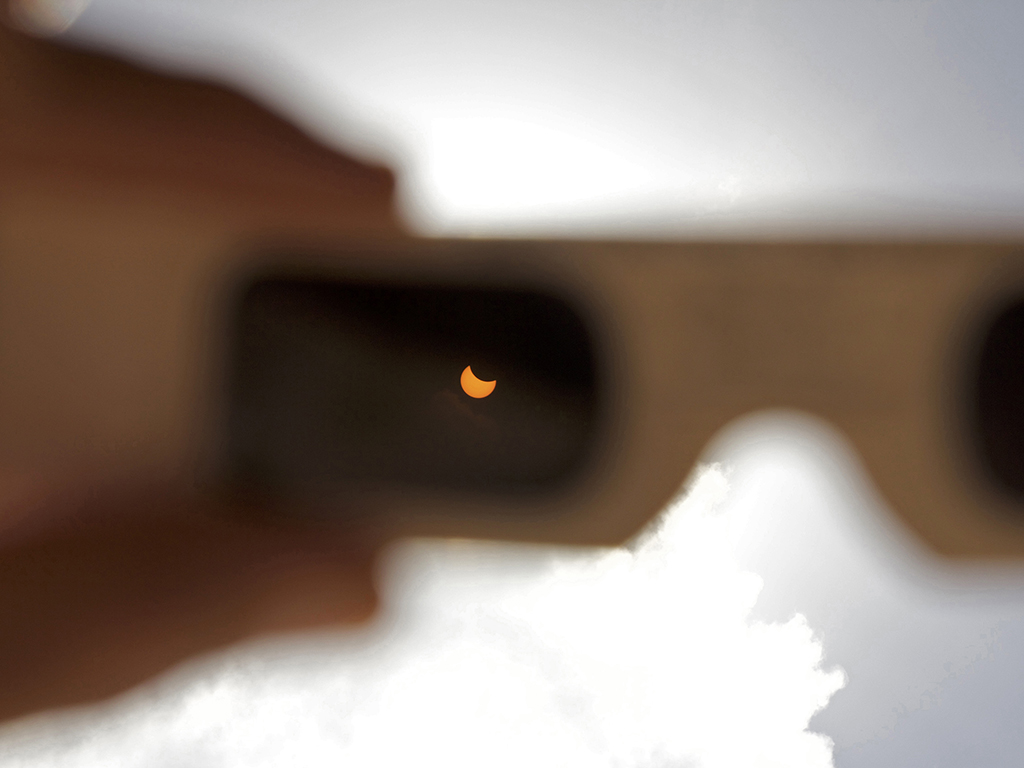How to Tell if Your Eclipse Glasses Are Unsafe (and What To Do About It)

This article was updated Aug. 7 after AAS provided more information about other bright lights that can be seen through safe eclipse glasses.
The American Astronomical Society (AAS) responded yesterday (Aug. 1) to increasing reports of unsafe solar eclipse glasses and solar viewers being sold to consumers ahead of the Aug. 21 total solar eclipse. The society updated its solar-viewing guidelines, which identify alternative viewing methods, ways to test if the eclipse glasses you have are unsafe and which welding goggles are OK for solar viewing.
Some eclipse glasses producers have been printing fake labels claiming the products are ISO-certified, and even providing fake test results online for their glasses. Because of this, AAS released more-comprehensive rules for finding out if your eclipse glasses are safe.
For one, if the glasses are manufactured or sold by companies on AAS's reputable vendors list, the organization has double-checked all paperwork to make sure the glasses are actually ISO-certified. [The Best ISO-Certified Gear to See the 2017 Solar Eclipse]
If you're unsure of the glasses' origin, or if their vendor is not on the list, there are still a few ways to tell if they might be unsafe. Safe eclipse glasses should be extremely dark, the AAS said.
"If you can see ordinary household lights through your eclipse glasses or handheld viewer, it's no good," AAS representatives wrote in their updated guide. "Safe solar filters produce a view of the sun that is comfortably bright (like the full moon), in focus and surrounded by black sky. If you glance at the sun through your solar filter and find it uncomfortably bright, out of focus and surrounded by a murky haze, it's [the viewer is] no good."
AAS later updated the guidelines to clarify that other lights comparable to the sun's brightness may be visible: "You shouldn't be able to see anything through a safe solar filter except the sun itself or something comparably bright, such as the sun reflected in a mirror, a sunglint off shiny metal, the hot filament of an unfrosted incandescent light bulb, a bright halogen light bulb, a multiple-white-LED flashlight, or an arc-welder's torch."
Breaking space news, the latest updates on rocket launches, skywatching events and more!
In that case, you should demand a refund or credit for the glasses and get a replacement from an approved vendor, the statement said. Glasses and viewers given out by amateur or professional astronomers, astronomical organizations, science museums, and planetariums are likely from those reputable vendors and therefore safe to use, the AAS said.
You should also inspect eclipse glasses and viewers to make sure they aren't scratched, punctured or torn, which could let additional light through.
Some welding filters are also safe to use to view the sun: those of shade 12, 13 or 14, AAS representatives said. However, they cautioned that most welding filters are lighter than that and that the sun can even be too bright in a shade 12 filter, while shade 14 tends to make the sun too dark.
Remember, whenever the sun is visible — even if it's just a small sliver — it is essential to view it through a solar filter. When you can't see anything through the filter, and the sun is completely obscured behind the moon, it is safe to look at the eclipse with the naked eye. Just be sure to use a filter again as soon as the sun begins to peek out.
People in areas with partial solar eclipses must wear protective filters through the entire eclipse if they hope to look at the sun.
If you didn't manage to get ISO-certified eclipse glasses or other gear, you still have some options to view the sun: You can hold up paper with a pinhole in it and view the sun projected downward, for instance, or view it projected down from a pair of binoculars.
You can even view the eclipse using this method without any props at all, the AAS said.
"An alternative method for safe viewing of the partially eclipsed sun is indirectly via pinhole projection," AAS wrote. "For example, cross the outstretched, slightly open fingers of one hand over the outstretched, slightly open fingers of the other, creating a waffle pattern. With your back to the sun, look at your hands' shadow on the ground. The little spaces between your fingers will project a grid of small images on the ground, showing the sun as a crescent during the partial phases of the eclipse. Or just look at the shadow of a leafy tree during the partial eclipse; you'll see the ground dappled with crescent suns projected by the tiny spaces between the leaves."
Editor's note: Space.com has teamed up with Simulation Curriculum to offer this awesome Eclipse Safari app to help you enjoy your eclipse experience. The free app is available for Apple and Android, and you can view it on the web. If you take an amazing photo of the Aug. 21 solar eclipse, let us know! Send photos and comments to: spacephotos@space.com.
Email Sarah Lewin at slewin@space.com or follow her @SarahExplains. Follow us @Spacedotcom, Facebook and Google+. Original article on Space.com.

Sarah Lewin started writing for Space.com in June of 2015 as a Staff Writer and became Associate Editor in 2019 . Her work has been featured by Scientific American, IEEE Spectrum, Quanta Magazine, Wired, The Scientist, Science Friday and WGBH's Inside NOVA. Sarah has an MA from NYU's Science, Health and Environmental Reporting Program and an AB in mathematics from Brown University. When not writing, reading or thinking about space, Sarah enjoys musical theatre and mathematical papercraft. She is currently Assistant News Editor at Scientific American. You can follow her on Twitter @SarahExplains.


